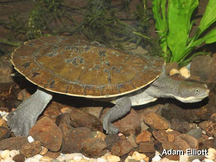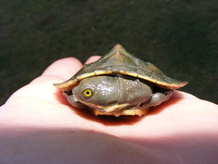The Murray River Turtle

The Murray River Turtle, Emydura macquarii, is a reptile that can grow to about 30 cm in length.
The majority of the shell is coloured dark brown, but the colours on the bottom of the shell are predominately creamy.
The skin of the Murray Turtle is generally grey as well as their being a dark yellow stripe running over the top of the head.
The Murray River Turtle belongs to the Chelidae family, which refers to freshwater turtles. The Murray turtle are primarily carnivorous and mainly fast on meat. There diet mainly includes small fish, slugs, snails, cricket, aquatic insect larvae and earthworms. They might also consume nontoxic aquatic plants. As the common name suggests, the turtle lives near rivers, lakes, lagoons and sometimes water holes around the Murray River region on the border of NSW and Victoria, south-east of Australia.
Image: Author: Adam Elliott Available at: http://coburgaquarium.com.au/images/livestock-gallery/reptiles-and-amphibians/turtles/images/ (turtle-murray-river-01.jpg) Accessed: July 6th 2015
The majority of the shell is coloured dark brown, but the colours on the bottom of the shell are predominately creamy.
The skin of the Murray Turtle is generally grey as well as their being a dark yellow stripe running over the top of the head.
The Murray River Turtle belongs to the Chelidae family, which refers to freshwater turtles. The Murray turtle are primarily carnivorous and mainly fast on meat. There diet mainly includes small fish, slugs, snails, cricket, aquatic insect larvae and earthworms. They might also consume nontoxic aquatic plants. As the common name suggests, the turtle lives near rivers, lakes, lagoons and sometimes water holes around the Murray River region on the border of NSW and Victoria, south-east of Australia.
Image: Author: Adam Elliott Available at: http://coburgaquarium.com.au/images/livestock-gallery/reptiles-and-amphibians/turtles/images/ (turtle-murray-river-01.jpg) Accessed: July 6th 2015
Habitats and abiotic factors
The Murray River Turtle lives is a mainly marine animal, but does walk on land every so often. Their are numerous abiotic factors that can affect the survival of the Murray River Turtle. These abiotic environments include temperature range and rainfall.
Temperature
The temperature around the Murray river and other marine environments in that region are on average consistently cool. The average temperature in the murray river environment was around 19 C in the summer and 12 C in the winter. The temperature doesn't really affect the activities of the Murray River Turtle as most of its hunting and daily activities takes place underwater, but the extremes of high and low temperature might have an impact on the temperature of the water. If there is a temperature change of the water then marine life living in the river might become less available as they might be less active, therefore impacting the daily food intake of the Murray River affecting its survival. This can be both a positive affect (increase in animals available for food due to warmer waters) or a negative affect (decrease in animals available for food due to colder waters).
Temperature range may also affect the development of eggs and their time to hatch. Especially if the water temperature is altered. Murray River Turtle eggs usually take 6-8 weeks to hatch, but with temperature ranges this duration might alter, both small and significantly. This can affect the survival of the young turtles and for the species to thrive in future years.
Rainfall
Rainfall is another abiotic factor that can affect the Murray River Turtle at the Murray River Marine environment. At the Murray river there is an average of 430mm of rain per year. The low amount of average water could possibly result in low river levels, therefore making it a limited environment for the turtles to survive in. Also with these low water levels the Murray River may also succumb to drought, making the surrounding environment have less water to survive. Species like turtles need water to be able to hunt, so with low levels of water from drought, the Murray River Turtle might not be able to move very far and for hunting.
Temperature
The temperature around the Murray river and other marine environments in that region are on average consistently cool. The average temperature in the murray river environment was around 19 C in the summer and 12 C in the winter. The temperature doesn't really affect the activities of the Murray River Turtle as most of its hunting and daily activities takes place underwater, but the extremes of high and low temperature might have an impact on the temperature of the water. If there is a temperature change of the water then marine life living in the river might become less available as they might be less active, therefore impacting the daily food intake of the Murray River affecting its survival. This can be both a positive affect (increase in animals available for food due to warmer waters) or a negative affect (decrease in animals available for food due to colder waters).
Temperature range may also affect the development of eggs and their time to hatch. Especially if the water temperature is altered. Murray River Turtle eggs usually take 6-8 weeks to hatch, but with temperature ranges this duration might alter, both small and significantly. This can affect the survival of the young turtles and for the species to thrive in future years.
Rainfall
Rainfall is another abiotic factor that can affect the Murray River Turtle at the Murray River Marine environment. At the Murray river there is an average of 430mm of rain per year. The low amount of average water could possibly result in low river levels, therefore making it a limited environment for the turtles to survive in. Also with these low water levels the Murray River may also succumb to drought, making the surrounding environment have less water to survive. Species like turtles need water to be able to hunt, so with low levels of water from drought, the Murray River Turtle might not be able to move very far and for hunting.
Challenges of living in certain environments
There are numerous challenges that Murray River Turtles have to face when in the marine environment.
- Pollution is a major problem of marine environments in general, and the Murray River is no exception. Pollution is of numerous kinds, but the Murray River is mainly Chemical pollution such as; petrol/oil spills, sewage and differences in pH level. This also impacts the water quality of the marine environment, so it makes travelling underwater for the Murray River Turtle a lot harder than usual.
- Floods and Droughts are also another challenge that Murray River Turtles face when in marine environments. When their is not enough water to sustain life, marine environments such as the Murray River Turtle cannot undertake the daily activities it usually does with limited water to move around and use as nutrients. When their is too much water their are chances of floods which can alter the environment if extreme. When not extreme it can make daily activities challenging for the Murray River Turtle as the water may become harder to travel through, putting more stress on the body of the Murray River Turtle.
Adaptations

The three main adaptations of the Murray River Turtle can help assist in the survival of the species.
These adaptations are structural, physiological and behavioural. These adaptations all help assist the survival of the species.
Structural: One of the adaptations that the Murray River Turtle has are the webbed feet. These can be used for enhanced and improved movement as they can push through the water a lot smoother, which can be handy for hunting and travelling. The other handy adaption is the shell on its back which can used for protection and defence.
Physiological: A Physiological adaptation that the Murray River Turtle has developed is clear vision above and below water. This can be handy when searching for pray underwater and also on the look out for potential predators above the water on the riverbank. Another physiological adaptation is the ability to able to hold their breath for long periods of time underwater when diving to look for small prey.
Behavioural: A behavioural adaptation that turtles have developed is their ability to withdrawal into its shell for protection. The image on the left shows the Murray River Turtle retreating into is shell and that it's head is bent sideways compared to some other species of turtles. Being able to retreating into the shell is an advantage as it can be used as a disguise.
Image: Author: Australian Freshwater Turtles Available at: http://www.australianfreshwaterturtles.com.au/forum/showthread.php?7834-Clarence-River-Turtle Accessed: July 8th 2015
These adaptations are structural, physiological and behavioural. These adaptations all help assist the survival of the species.
Structural: One of the adaptations that the Murray River Turtle has are the webbed feet. These can be used for enhanced and improved movement as they can push through the water a lot smoother, which can be handy for hunting and travelling. The other handy adaption is the shell on its back which can used for protection and defence.
Physiological: A Physiological adaptation that the Murray River Turtle has developed is clear vision above and below water. This can be handy when searching for pray underwater and also on the look out for potential predators above the water on the riverbank. Another physiological adaptation is the ability to able to hold their breath for long periods of time underwater when diving to look for small prey.
Behavioural: A behavioural adaptation that turtles have developed is their ability to withdrawal into its shell for protection. The image on the left shows the Murray River Turtle retreating into is shell and that it's head is bent sideways compared to some other species of turtles. Being able to retreating into the shell is an advantage as it can be used as a disguise.
Image: Author: Australian Freshwater Turtles Available at: http://www.australianfreshwaterturtles.com.au/forum/showthread.php?7834-Clarence-River-Turtle Accessed: July 8th 2015
Rhythmic Patterns
The Murray River Turtle has many useful rhythmic patterns. One of the major Rhythmic patterns is that it is active during a Diurnal time period. The purpose of being active in the day is that it gives the turtle more light to see around its environment more easily, so that it travel, catch prey and watch for predators. If this was to be undertaken throughout the night it would be much harder for the Murray River Turtle to complete daily activities it needs to survive.
Interesting Fact
In the spring and summer, The Murray River Turtles lay eggs in a burrow near the water's edge. These hatch about 80 days later!
Video
The following clip shows The Murray River Turtle demonstrating its social ability, while swimming in the murray river.
Video by vikingtimbo Link: https://www.youtube.com/watch?v=0dEbAcV90eU
Video by vikingtimbo Link: https://www.youtube.com/watch?v=0dEbAcV90eU
